The Hisense AX5100G offers a lot of equipment for the money. What is doesn’t offer, though, is an audio experience that’s in any way enjoyable
Pros
- Offers genuine surround sound
- HDMI eARC is a rarity at this price
- Nicely built and finished
Cons
- Unpleasant and antagonistic tonality across the board
- No discernible spatial audio effect
- Subwoofer is estranged from the rest of the system
Introduction
Hisense is no stranger to the concept of affordable electronics – its TVs, especially, routinely punch above the weight of their modest asking prices.
With the AX5100G, the Chinese manufacturer intends to bring some of its bargainous expertise to bear in the soundbar arena – basically by offering a sight more stuff for your money than pretty much any competitor can manage. It’s worked before for Hisense – can it work again?
Availability
- UKRRP: £229
- USARRP: $199.99
- EuropeRRP: €269
- Canadaunavailable
- AustraliaRRP: AU$499
The Hisense AX5100G Dolby Atmos 5.1-channel audio system is on sale now, and in the United Kingdom it’s priced at an extremely keen £229. In the United States, meanwhile, it costs an even more attention-grabbing $199. Australian customers will have to part with AU$499 to secure one.
This is remarkably affordable for a Dolby Atmos audio system that consists of a soundbar, a wireless subwoofer and a pair of wireless rear speakers all configured to deliver a 5.1-channel facsimile of Dolby Atmos spatial audio.
Design
- Good standard of build and finish
- Usefully compact dimensions
- Wired wireless rear speakers
It’s foolish to expect much designing to have gone on where systems like this are concerned, and it’s doubly rash to expect some when shopping at the budget end of the market. And sure enough, the AX5100G hasn’t been designed so much as constructed. That’s not a put-down, you understand – the Hisense is entirely fit for purpose.
The soundbar portion is a tidy 60 x 920 x 90mm (HxWxD), which means it will slip comfortably beneath any TV that doesn’t sit very low on its stand and can accompanying screens of anywhere between 43- and 58-inches. If your TV’s any bigger than that, this soundbar might look a bit undernourished. It’s built from a combination of textured plastic and perforated metal, is quite pleasantly curved at its edges and is even mildly tactile. The quality of fit and finish is beyond reproach, too.
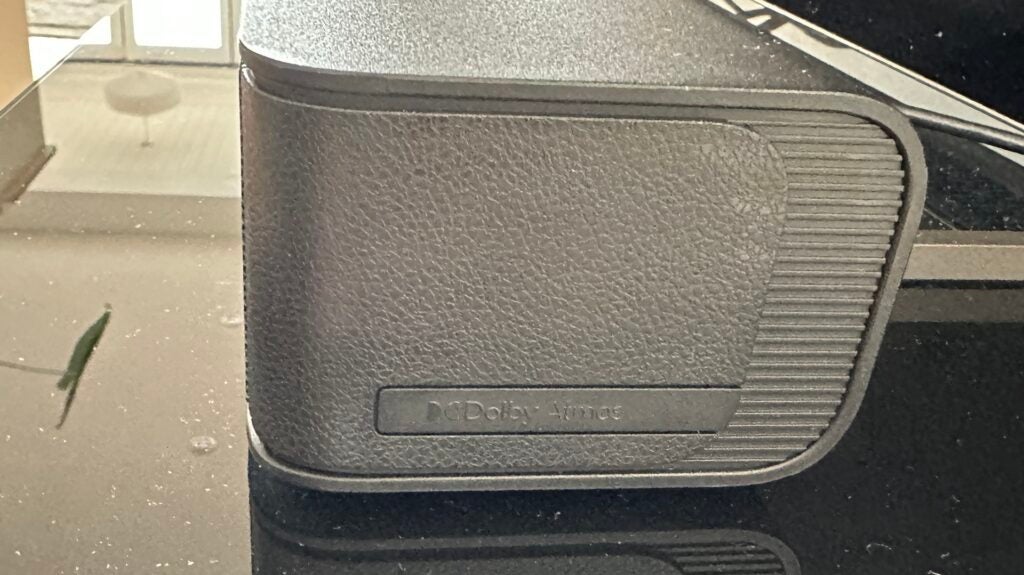
The subwoofer, meanwhile, is an equally manageable 294 x 214 x 304mm (HxWxD). It too features a quality of perforated metal on its front face, but predictably the rest of it is vinyl-wrapped MDF. Build quality, as with the soundbar and rear speakers, is perfectly acceptable. It’s worth noting that unlike a lot of similarly priced alternatives, this subwoofer uses a figure-of-eight mains power connection rather than a captive mains lead – this makes it a fair bit more flexible as regards positioning that it otherwise would be.
The rear speakers are wireless too, but only up to a point. There’s a primary speaker with a figure-of-eight mains power connection and a pairing button. The subwoofer has one too, but in practice both the sub and the rears make an automatic connection to the soundbar very rapidly indeed.
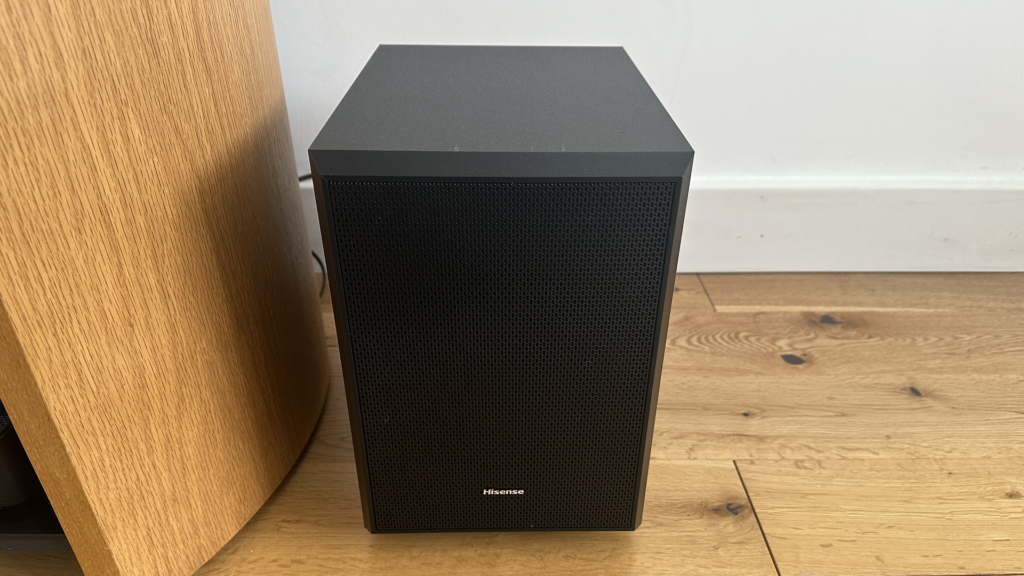
Then the primary speaker has to be connected to the secondary speaker using the generous length of cable Hisense provides. Each speaker is 144 x 90 x 109mm (HxWxD), features little rubber feet in case you want to put them on a shelf and a keyhole mounting point on the rear in case you don’t. They’re made from the same textured plastic and perforated metal as the soundbar – but here the metal wraps over the top.
The suggestion that the cabinet features upward-firing Atmos-tastic drivers is visually strong – but it’s also untrue. Just like the rest of the system, though, the rear speakers are hard to criticise where construction is concerned.
Features
- Almost certainly 170 watts of power
- HDMI eARC, Bluetooth 4.2
- Seven drivers delivering 5.1-channel sound
Despite what the rear speakers might try to convince you of, the seven speaker drivers that make up the AX5100G all fire forwards. There are four racetrack drivers in the soundbar: two fire from more-or-less centrally, and constitute the centre channel, while one more at each end make up the left and right channels.
The size and composition of the drivers is, inexplicably, a secret – but what’s for sure is that in the absence of any dedicated tweeters they’re responsible for all frequency information above what’s contributed by the subwoofer.
The subwoofer’s 165mm bass driver is augmented by a rear-facing bass reflex port – so despite what I said in the previous section, you’ll have to give at least a little thought as to where you end up positioning it.
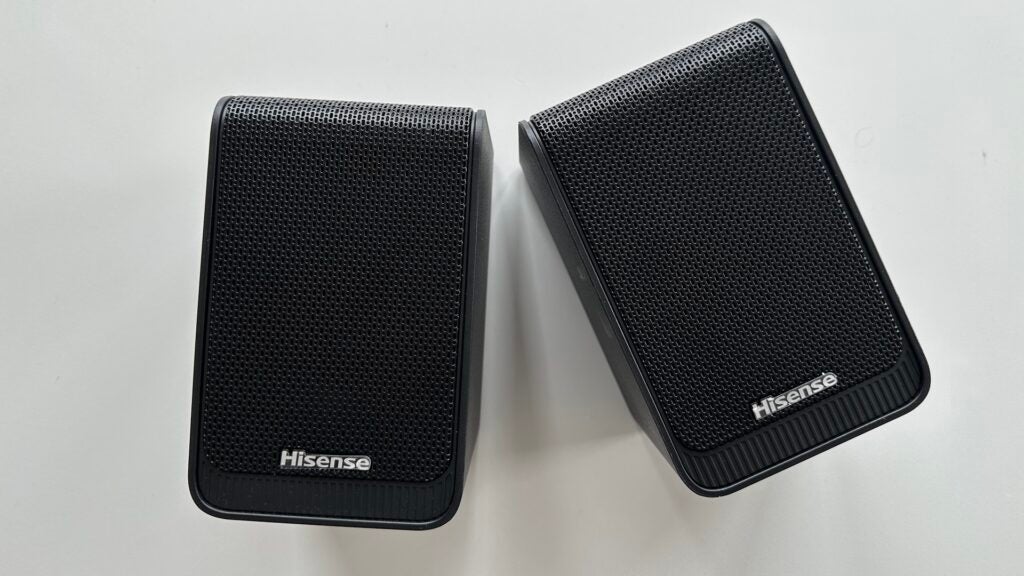
The rear speakers are the trickiest, though. The soundbar obviously goes in front of your TV, the subwoofer wherever it can get mains power and wherever its rear port doesn’t overpower, but the forward-firing rear speakers need to be angled in to your seated position while being close enough together to be tethered. As with the soundbar, the size of the drivers in the rear speakers is, for some reason, sensitive information. And it’s not the only area of specification where Hisense is unforthcoming.
All connectivity, naturally enough, is concentrated on the soundbar. Wireless streaming is handled via Bluetooth 4.2 – but, you’ll be less than staggered to learn, Hisense is coy about its codec compatibility. SBC is available, naturally – and in the course of this test I manage to establish the Hisense can handle Dolby Atmos audio content from Tidal streamed from an iPhone 14 Pro using the AAC codec. Switching to a Nothing Phone (1) reveals a lack of aptX compatibility, though, and consequently no possibility of listening to spatial audio mixes from an Android smartphone.
Physical connectivity, in a little recess on the rear of the soundbar, runs to HDMI eARC, digital optical, digital coaxial, a USB-A slot and a 3.5mm analogue input. The appearance of eARC is by no means a given in products in this area of the market – and it means the Hisense can handle the lossless Dolby True HD variety of Dolby Atmos that’s the preserve of 4K UHD Blu-ray players, as well as the lossy Dolby Digital Plus alternative used by the likes of Disney+ and Netflix.
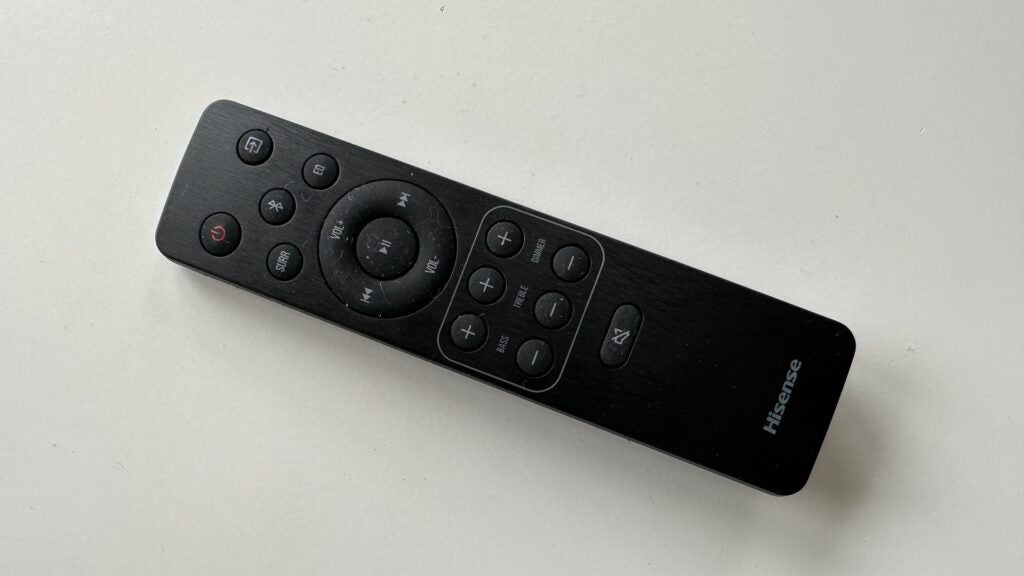
There are a few (almost invisible) touch-controls on the top of the soundbar. They cover input selection, volume up/down and power on/off. The AX5100G is supplied with a remote control handset that’s perfectly acceptable both in terms of size and weight, and it features both full functionality and some very small labelling for its buttons.
As well as duplicating the physical controls, it covers Bluetooth pairing, mute, and has individual output controls for bass and treble. There’s play/pause and skip forwards/backwards here too, a button to scroll through EQ presets (Movie, Music, News, Game, Sport, Night and, um, AI), and control over the intensity of the display that’s behind the grille on the soundbar’s front face. The display itself is quite big and quite indistinct, and it scrolls quite quickly. The words Dolby Atmos, for example, are dispatched in comfortably under a second.
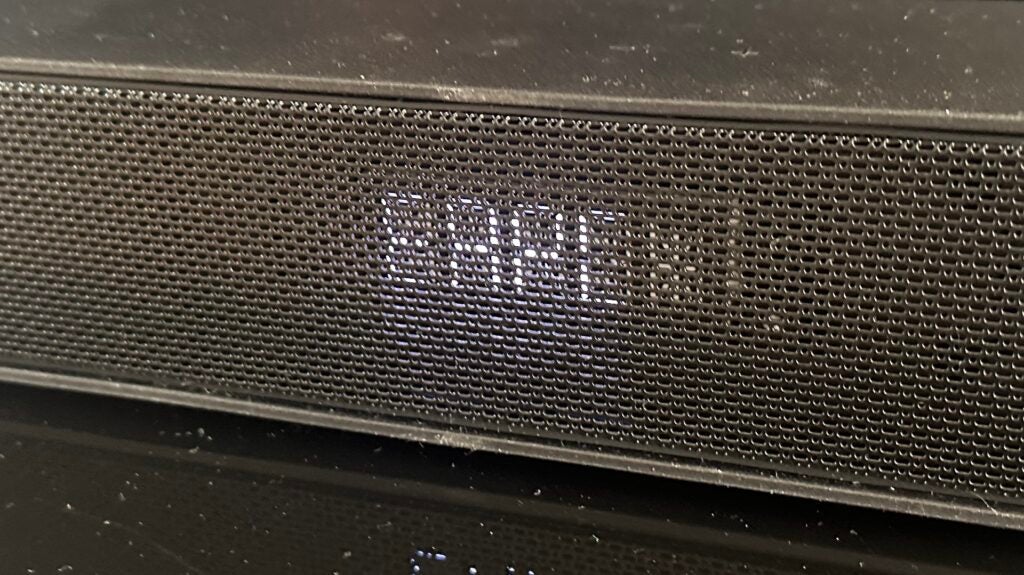
According to its owner’s manual, the AX5100G has a total of 170 watts of power. The soundbar gets 80 of these Class D watts (20 per driver), the subwoofer receives 60 watts and the rear speakers get 15 watts each. This seems like a plausible figure, even if it’s measured at a sky-high 10% THD (total harmonic distortion). It makes the Hisense website’s claim for 340 watts of power seem a bit weird, though.
Sound Quality
- Tonality is wildly inconsistent
- Negligible impression of spatial audio
- Actual, authentic surround sound
There seems very little point in beating around the bush here: the Hisense AX5100G just doesn’t sound very good. Tonally, it’s all over the place. Rhythmically, it has two left feet. The Dolby Atmos effect, virtualised, of course, rather than being the result of angled speaker drivers, is so mild as to be non-existent. And not only do the three elements of the system (soundbar, subwoofer, rear speakers) share little in terms of tonality, they’re barely on nodding terms where integration is concerned.
Thin and zizzy are seldom encouraging words where audio equipment is concerned, but with the exception of the subwoofer they’re completely applicable here. Somehow the Hisense soundbar manages to sound edgy and toppy despite its lack of actual tweeters, and there’s precious little substance to the sounds it makes through the midrange, too.
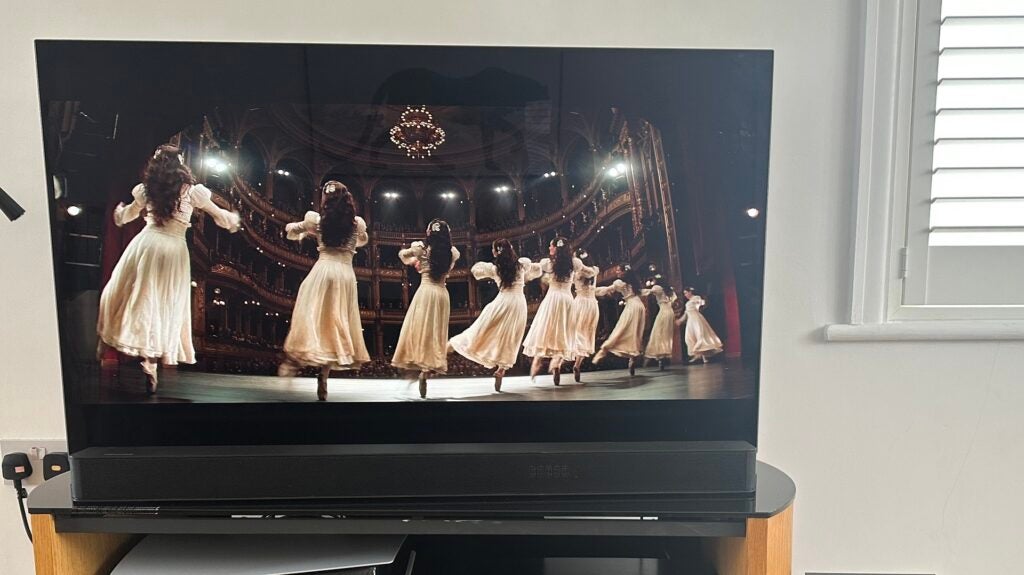
Detail levels are no better than average, and no matter which of the EQ presets I choose, dialogue struggles to project ahead of the hard, brittle sounds that surround it. The story is much the same where the rear speakers are concerned. Their tonality just doesn’t convince – they contrive to sound insubstantial and airy, but hard-edged and toppy at the same time.
Meanwhile, the subwoofer just does its own thing. It’s not especially detailed – which is one thing it has in common with its partners, at least – but its tonality is thick and sludgy, with insufficient attention paid to the attack and decay of individual bass sounds. It’s a bit of a droner, this subwoofer, and the transition from it to its partnering speakers is abrupt.
Listen to the Dolby Atmos soundtrack to Dune and the lack of low-frequency control makes everything subservient to the bass presence. Listen to Nina Simone’s Don’t Let Me Be Misunderstood in a Dolby Atmos mix via Tidal and the inimitable vocal sounds like it was recorded down the telephone.
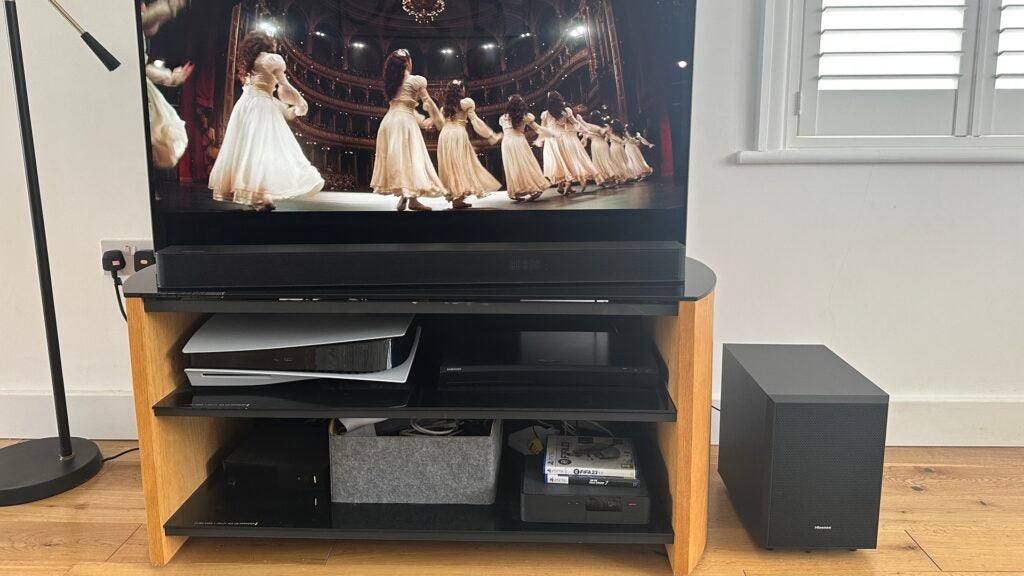
The fact that there are rear speakers at work here means the Hisense is a bigger, more expansive and more immersive listen than a soundbar working alone – that’s a given. But what the AX5100G can’t muster, despite the relative numerousness of its components, is any meaningful sensation of spatial audio.
The soundbar creates decent width, and if you’ve positioned the rear speakers correctly then you’ll most definitely get surround sound – but of the sensation of height that’s basically the whole point of a Dolby Atmos mix is absent. Whatever processing Hisense is bringing to bear to deliver some verticality to the AX5100G’s presentation is not earning its keep.
The Dune soundtrack does demonstrate the system’s competence where the bigger dynamic shifts are concerned, though – it can go from tinny whispering to overpowering, baleful attack quite readily and quite rapidly. But as far as positive traits go, I’m in straw-clutching territory now.
Latest deals
Should you buy it?
You’re determined to achieve true surround sound without spending lots of money: No other manufacturer throws rear speakers into a deal this keenly priced.
You want a reasonably balanced, tonally coherent sound: The Hisense is – and I’m being charitable here – socially challenged.
Final Thoughts
If it had been any other brand, I’d have suspected this would be the outcome right from the start. But because Hisense has so much previous where extracting unlikely performance at any given price is concerned, I actually entered into this test with my fingers crossed and my hopes… well, not high, but at least I had hopes. They didn’t last long, though.
How we test
We test every surround speaker package we review thoroughly over an extended period of time. We use industry standard tests to compare features properly. We’ll always tell you what we find. We never, ever, accept money to review a product.
FAQs
There are no upward firing drivers in this speaker package, the Atmos effect is created by virtual processing.
Sustainability
Trusted Reviews’ holds the fact that global warming is not a myth as a core value and will continuously endeavour to help protect our planet from harm in its business practices.
As part of this mission, whenever we review a product we send the company a series of questions to help us gauge and make transparent the impact the device has on the environment.
We currently haven’t received answers to the questions on this product, but will update this page the moment we do. You can see a detailed breakdown of the questions we ask and why in our sustainability info page.
Jargon buster
Dolby Atmos
Dolby Atmos is an object-based audio format. It expands on 5.1 and 7.1 soundtracks by adding overhead channels. Sounds are referred to as “audio objects”, of which there can be up to 128 audio channels, and these ‘objects’ can be accurately positioned within a 3D soundscape. This allows soundtracks that support the technology to place sounds above and around the listener with compatible kit.

























